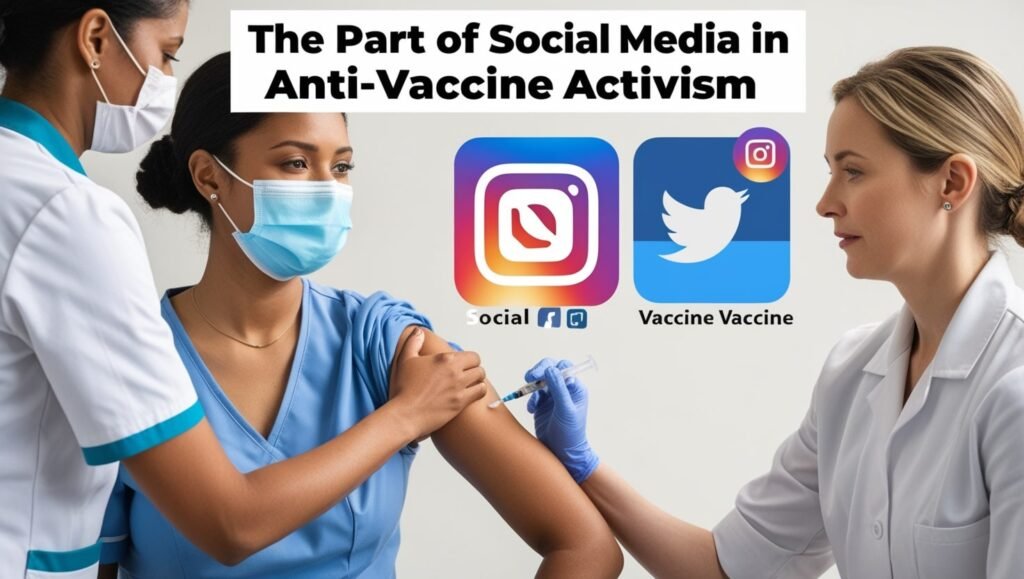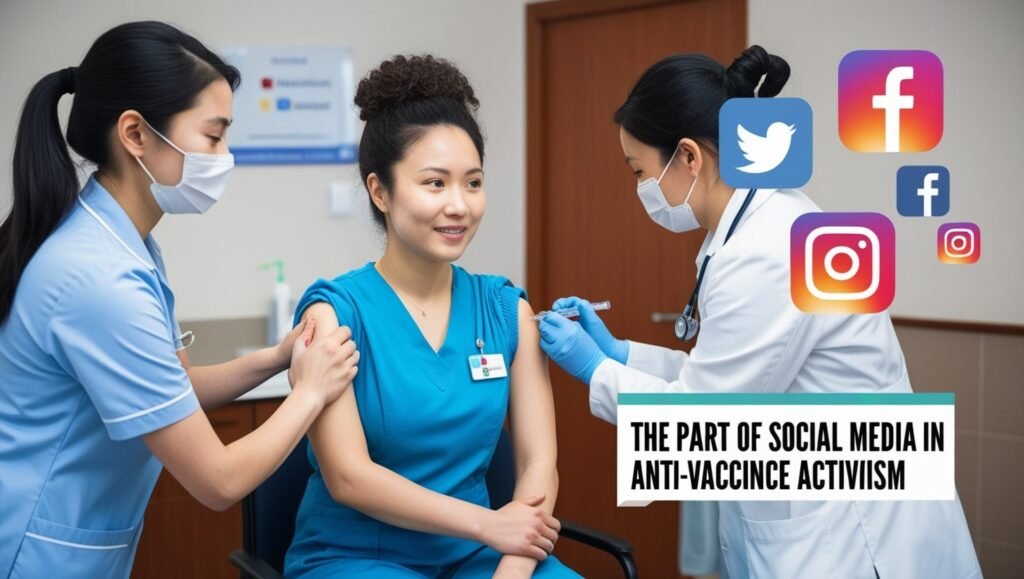Introduction To Social Media in Anti-Vaccine Activism
In later a long time, anti-vaccine activism has become a developing concern, particularly with the rise of social media. Anti-vaccine activism alludes to organized resistance to immunizations, frequently established in the conviction that antibodies are hurtful or pointless. This development is not unused, but the development of social media stages has altogether increased its reach, making deception simpler to spread. Social media has reshaped communication, advertising anti-vaccine bunches the capacity to interface, lock-in, and mobilize speedier than ever before.

Historical Context
Evolution of Anti-Vaccine Sentiments
The roots of anti-vaccine opinions date back to the 18th century when Edward Jenner’s smallpox immunization was to begin with presented. Since that point, skepticism toward immunizations has held on, advancing due to social, logical, and social components. In cutting-edge times, critical occasions such as the 1998 Wakefield consider, erroneously connecting the MMR (measles, mumps, rubella) antibody to extreme introvertedness, fueled broad fear and skepticism.
Key Occasions That Fueled Anti-Vaccine Movements
The Wakefield thing was a basic turning point for the anti-vaccine development, despite being debunked and withdrawn. Open fears encompassing immunizations were moreover fed by personal cases of unfavorable impacts, which were frequently overstated or misjudged. Celebrity support, such as articulations made by Jenny McCarthy, advance legitimized these fears, giving the development a confront and voice in standard media.
Social Media Stages and Their Impact
Major Stages Utilized by Anti-Vaccine Activists
Anti-vaccine activists have found a prolific ground for their development over different social media stages. Each stage offers interesting instruments for engagement, but they all play a basic part in opening up anti-vaccine messages.
- Facebook: With its bunches and communities, Facebook empowers activists to make reverberate chambers where anti-vaccine substances flourish without much pushback.
- Twitter: The brevity of tweets makes it simple to share brief, impactful messages, frequently filled with deception that spreads rapidly through retweets.
- Instagram: Visual substance on Instagram, especially memes and infographics, can be exceedingly locked in and effortlessly shared among clients, making a difference in deception go viral.
- YouTube: Long-form video substance, such as individual declarations or documentaries, permits for a more in-depth investigation of anti-vaccine narratives.
Mechanisms of Data Dissemination
Anti-vaccine substances spread quickly through an assortment of instruments that take advantage of how social media functions.
- Viral Substance: Posts that inspire solid emotions—whether fear, outrage, or sadness—tend to go viral more effortlessly. This virality plays a key part in anti-vaccine development, where fear-based informing regularly garners noteworthy attention.
- Echo Chambers: Social media calculations frequently appear clients’ substance that adjusts with their existing convictions, making resound chambers where deception is persistently reinforced.
Strategies Utilized by Activists
Misinformation and Disinformation Tactics
Anti-vaccine activists depend intensely on deception (untrue data shared without destructive expectation) and disinformation (intentionally wrong data) to influence open conclusions. These strategies regularly incorporate skewing information, confusing logical ponders, or making unjustifiable claims about immunization security and efficacy.
Use of Individual Accounts and Testimonials
Personal stories, particularly those that include negative immunization encounters, are capable apparatuses. These accounts deliver a human confrontation to anti-vaccine contentions, making the issue feel more individual and quick to others. Whereas these stories may not speak to the broader reality, their passionate weight frequently dominates logical data.
Emotional Offers and Fear-Based Messaging
Anti-vaccine activists frequently utilize enthusiastic requests to incite fear and vulnerability. By centering on potential side effects—often overstated or fabricated—they create an air of doubt. Fear-based informing, particularly when it includes children, can be profoundly influential and troublesome to counter with rationale alone.

Audience Engagement
Target Socioeconomics of Anti-Vaccine Content
The anti-vaccine development tends to target particular socioeconomics. Guardians, especially those with youthful children, are an essential group of onlookers because of the coordinated effect that immunization plans have on their families. Moreover, those who are doubtful of government education or are slanted toward elective medication are regularly responsive to anti-vaccine messaging.
Methods for Community Building and Mobilization
Social media stages permit the creation of online communities where like-minded people can assemble, share data, and strengthen each other’s convictions. These communities are regularly closed or private, making it troublesome for exterior voices to offer diverse perspectives.
The Part of Influencers and Supposition Leaders
Influencers, both celebrities and micro-influencers, play a critical part in spreading anti-vaccine assumptions. Their stages allow them validity, and when they talk against immunizations, their supporters are more likely to embrace the same sees. Supposition pioneers inside anti-vaccine communities moreover use impressive control, regularly forming the movement’s informing and strategies.
Counteractions from Open Wellbeing Officials
Strategies to Combat Misinformation
In reaction to the developing impact of anti-vaccine substances on social media, open well-being authorities have been executing different procedures to combat deception. This incorporates making instructive campaigns, giving precise data, and working with social media stages to hail or expel destructive content.
Importance of Advanced Proficiency and Basic Thinking
Public well-being campaigns presently emphasize the requirement for computerized education and basic consideration. Empowering individuals to address the sources of data they devour and to confirm claims through trustworthy channels is pivotal in the battle against misinformation.
Case Ponders of Effective Interventions
There have been a few effective intercessions where open wellbeing authorities and stages have worked together to diminish the spread of anti-vaccine substances. For case, YouTube has demonetized anti-vaccine channels, and Facebook has presented measures to constrain the reach of anti-vaccine groups.
Conclusion
In rundown, social media has played an essential part in the rise of anti-vaccine activism by giving a stage for the quick spread of deception, cultivating community engagement, and permitting activists to utilize enthusiastic and fear-based strategies. Moving forward, it will be pivotal for open wellbeing activities to proceed creating procedures to neutralize this developing impact and ensure open health.
FAQs
What is anti-vaccine activism?
- Anti-vaccine activism alludes to organized endeavors to contradict immunizations, regularly based on deception and disinformation concerning the security and adequacy of vaccines.
How has social media affected anti-vaccine activism?
- Social media has opened up anti-vaccine informing by permitting activists to spread deception quickly and construct like-minded communities, making the development more unmistakable and accessible.
What procedures do anti-vaccine activists utilize on social media?
- They depend on deception, enthusiastic requests, fear-based informing, and individual accounts to induce individuals, regularly making resound chambers where these messages thrive.
How can open well-being authorities neutralize misinformation?
- By advancing computerized education, propelling instructive campaigns, collaborating with social media stages, and utilizing fact-checking instruments, open well-being authorities can decrease the spread of misinformation.
What does the future hold for the fight between pro-vaccine and anti-vaccine movements?
- As social media proceeds to advance, the fight will likely heighten, making it vital for open well-being authorities to improve modern ways to lock in the open and advance precise data.


